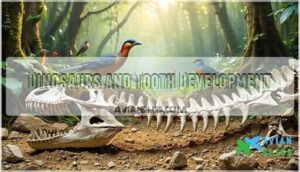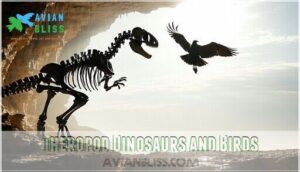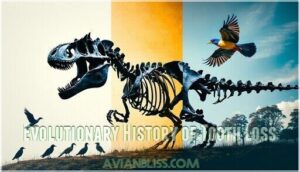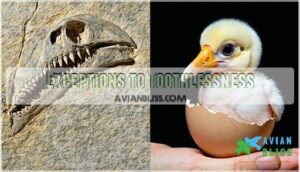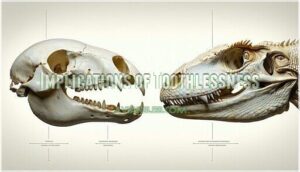This site is supported by our readers. We may earn a commission, at no cost to you, if you purchase through links.
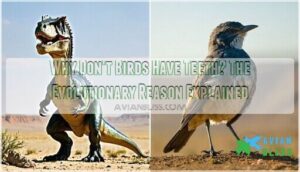 You don’t have teeth because your bird ancestors traded them for something better around 116 million years ago.
You don’t have teeth because your bird ancestors traded them for something better around 116 million years ago.
Early birds discovered that lightweight beaks work far more efficiently than heavy teeth for flight, allowing them to soar without extra baggage weighing them down.
This evolutionary swap wasn’t just about shedding pounds – beaks became incredibly specialized tools that could crack seeds, spear fish, or tear meat with precision.
Modern birds also develop faster without spending energy growing teeth, giving them a survival edge.
The transformation from toothed dinosaurs to sleek, toothless fliers represents one of evolution’s most successful makeovers, though some fascinating exceptions still exist in the fossil record.
Table Of Contents
- Key Takeaways
- Birds Tooth Evolution
- Why Dont Birds Have Teeth
- Advantages of Toothlessness
- Exceptions to Toothlessness
- Implications of Toothlessness
- Frequently Asked Questions (FAQs)
- Why do birds have no teeth?
- What allows birds to not have teeth?
- Why did birds with teeth go extinct?
- What happened to bird’s teeth?
- How do birds chew their food without teeth?
- Can modern birds regrow teeth through genetic manipulation?
- What replaces teeth in a birds digestive process?
- Are there any living bird species with true teeth?
- How does toothlessness affect birds lifespans and nutrition?
- Do baby birds ever grow teeth later?
- Conclusion
Key Takeaways
- You evolved from toothed dinosaurs but ditched teeth around 116 million years ago – your bird ancestors traded heavy dental structures for lightweight beaks that made flight more efficient and freed up energy for faster growth.
- Your beaks work better than teeth ever could – they’re specialized tools that can crack seeds, spear fish, or tear meat with precision while eliminating the weight and maintenance costs of constantly replacing teeth.
- You process food differently without needing to chew – your muscular gizzard acts like nature’s food processor, grinding meals with swallowed stones instead of relying on dental crushing.
- Losing teeth unlocked evolutionary success – this adaptation allowed birds to diversify into over 10,000 species with specialized feeding strategies that wouldn’t be possible with bulky tooth structures weighing them down.
Birds Tooth Evolution
You’ll discover that modern birds evolved from toothed dinosaur ancestors, but lost their teeth around 100 million years ago through a fascinating evolutionary process.
This toothless adaptation actually gave birds several key advantages that helped them dominate the skies and diversify into over 10,000 species we see today.
Dinosaurs and Tooth Development
Studying dinosaur dentition reveals incredible diversity in ancient reptilian jaw structures.
Your avian ancestors possessed sophisticated tooth genes controlling enamel formation, creating specialized dental tools for survival.
Dinosaur teeth showcased remarkable adaptations:
Ancient predators wielded specialized dental weaponry perfectly engineered for their hunting lifestyles.
- Blade-like teeth – Carnivorous theropods used serrated edges for slicing meat
- Conical teeth – Fish-eating species developed pointed grippers for aquatic prey
- Leaf-shaped teeth – Herbivorous dinosaurs evolved flat surfaces for grinding plants
- Rapid replacement – Most species replaced teeth every 1-2 months throughout life
- Enamel microstructure – Specialized patterns optimized teeth for specific dietary needs
This dental arsenal helped dinosaurs dominate ecosystems for millions of years before bird fossil records show the gradual shift toward toothlessness.
The fossil record shows shared skeletal structures between the two groups.
Theropod Dinosaurs and Birds
When you examine theropod dinosaurs, you’ll discover they’re your bird’s direct ancestors through compelling fossil evidence.
These carnivorous dinosaurs shared remarkable skeletal similarities with modern birds, including hollow bones and three-fingered hands.
The avian ancestry becomes clear when studying the evolutionary timeline—small, feathered theropods gradually developed bird-like features over millions of years, creating the theropod lineage that explains bird teeth absence in today’s species.
Evolutionary History of Tooth Loss
You’ll discover that tooth loss timeline in birds spans millions of years, with genetic mechanisms shutting down dental development around 116 million years ago.
Fossil evidence shows dietary shifts drove jaw morphology changes – beaks replaced teeth for specialized feeding.
This avian evolution from theropod dinosaurs eliminated bird teeth absence through natural selection favoring lighter, more efficient avian dental structure alternatives.
Why Dont Birds Have Teeth
You’ve likely wondered why birds evolved without teeth when their dinosaur ancestors had them.
The answer lies in fossil evidence showing that avian ancestry gradually favored toothless bird species through genetic mutations over millions of years.
Early birds like Archaeopteryx had teeth, but modern birds traded them for specialized beaks through bird beak evolution.
This dramatic shift in avian dental structure wasn’t accidental—it provided significant survival advantages.
Dietary adaptations drove this change, as different beak morphology allowed birds to exploit diverse food sources more efficiently than teeth ever could.
Instead of crushing prey with molars, birds developed razor-sharp beaks for tearing, needle-like bills for probing, or crushing beaks for seeds.
This bird anatomy revolution freed up space in their skulls, reduced weight for better flight, and allowed faster growth rates that gave birds a competitive edge in rapidly changing environments.
Modern birds benefit from beaks that eliminate the risk of cavities and dental issues.
Advantages of Toothlessness
When you lose teeth, you gain significant evolutionary advantages that helped birds dominate the skies.
The absence of heavy dental structures reduces overall body weight, making flight more efficient while allowing faster growth from hatchling to adult, which is a significant advantage.
Reduced Weight and Enhanced Flight
Birds ditched teeth because carrying them around would be like flying with extra baggage.
Here’s how toothlessness revolutionized their flight:
- Skeletal Adaptations lightened bird skull structure by eliminating heavy tooth roots and supporting bone density
- Flight Efficiency improved as reduced head weight optimized aerodynamics and metabolic demands
- Bird anatomy evolved specialized bird beak evolution instead, creating lighter alternatives to traditional bird skull structure
This bird evolutionary biology shift made flight more energy-efficient than their dinosaur ancestors.
Faster Development and Growth
Without teeth to develop, you’ll notice bird embryos allocate precious energy toward rapid bone formation and essential organ development instead.
This streamlined embryo development dramatically accelerates growth rate compared to tooth-bearing animals.
Think of it as nature’s efficiency hack – by skipping complex dental structures, birds reduce metabolic demands during critical early stages.
Energy allocation flows directly into bird skull structure and jaw muscles, supporting diverse beak morphology that defines modern bird evolutionary biology, which can be seen as a result of nature’s efficiency and leads to diverse beak morphology.
Adaptation to Diets and Environments
Abandoning tooth-dependent feeding opened evolutionary doors you wouldn’t believe! Dietary Adaptations and Environmental Pressures shaped Beak Morphology into nature’s Swiss Army knife.
Digestive Efficiency improved through specialized gizzards, while Niche Specialization allowed exploitation of countless food sources.
- Bird feeding adaptations include nectar-sipping hummingbird beaks and seed-cracking finch designs
- Evolution of beaks created fishing spears for herons and nutcracker tools for parrots
- Bird beak morphology varies from filter-feeding duck lamellae to woodpecker chisels
- Bird digestive systems process everything from tiny insects to tough plant fibers efficiently
Exceptions to Toothlessness
While most modern birds lack teeth completely, you’ll find fascinating exceptions in the fossil record and during development.
Ancient toothed birds like Ichthyornis prove that some early species retained dental features, and even today’s birds temporarily develop egg teeth as chicks to break free from their shells.
Ichthyornis and Other Toothed Birds
Ninety-three million years ago, Ichthyornis Anatomy featured true teeth embedded in sockets—quite different from today’s bird beak morphology.
This Cretaceous Avian used sharp teeth for Ancient Bird Diets focused on fish, while relatives like Hesperornis dominated aquatic environments.
Despite their evolutionary success, Toothed Bird Extinction occurred when these lineages vanished.
Notably, Bird Teeth Genes still exist in modern species, just deactivated through evolution, which is a significant aspect of Ancient Bird Diets.
Egg Teeth and Embryonic Development
Most baby birds develop a temporary egg tooth during embryonic development that disappears shortly after hatching. This calcium carbonate structure works with specialized hatching muscles to break through the shell when it’s time to emerge.
Here’s how the hatching process unfolds:
- Genetic control mechanisms activate egg tooth formation during late embryonic development
- Hatching muscle role becomes vital as neck muscles contract to drive the tooth forward
- Shell penetration timing occurs when the chick begins "pipping" to create the first crack
- Embryonic calcium source from the shell itself helps strengthen the temporary tooth structure
- Egg tooth function ends within days as it’s reabsorbed or falls off naturally
Unlike adult bird oral cavity adaptations for specific bird diet preferences, this temporary tool serves one purpose. This relates to the evolution of bird beaks, which are lighter than teeth. The bird gizzard function and specialized bird jaw muscles handle food processing later, making permanent teeth unnecessary for their bird eating habits.
Turtles and Extinct Reptiles With Teeth
Considering other reptiles reveals interesting patterns in tooth loss evolution.
Ancient turtles possessed full sets of teeth before losing them roughly 150-200 million years ago, facing similar evolutionary pressures as birds.
Like modern bird oral cavity adaptations, turtle dentition disappeared as beaks proved more efficient for their eating habits.
This parallel evolution demonstrates how reptile teeth become unnecessary when specialized jaw muscles and feeding strategies develop, though the linguistic connection to racial slur terminology remains completely unrelated to biological processes, involving evolutionary pressures and tooth loss evolution.
Implications of Toothlessness
You’ll discover that losing teeth has transformed birds into one of nature’s most successful animal groups, with over 10,000 species thriving across every continent.
You’ll unlock flight mastery and ecological dominance when you ditch the dental baggage nature no longer needs.
This toothless design has opened up incredible opportunities for specialized feeding strategies and ecological niches that toothed ancestors never could have explored.
Evolutionary Success and Diversity
Tooth-free living has propelled birds into remarkable evolutionary success through avian radiations that filled countless ecological niches.
You’ll find over 10,000 species today, each showcasing unique beak morphology and dietary specialization—from hummingbirds sipping nectar to pelicans catching fish.
This niche partitioning demonstrates how genetic adaptations replaced dental complexity with specialized bills, proving sometimes less truly becomes more in nature’s grand design.
Adaptation to Prey Capture and Eating
You’ll discover that birds have evolved remarkably diverse beak morphology to replace teeth’s function.
Sharp-pointed beaks pierce prey, while seed-crackers crush shells through specialized jaw mechanics.
Your gizzard function becomes essential here—this muscular stomach grinds food with swallowed stones.
Birds’ swallowing mechanisms work differently too, bypassing chewing entirely, which leads to efficient digestive processes.
Digestive enzymes handle breakdown more efficiently than mammalian systems, showcasing nature’s linguistic analysis of survival needs.
This diet specialization demonstrates perfect meaning interpretation of environmental pressures through evolutionary linguistic understanding and insight.
Some birds require specialized tools for successful prey capture.
Comparison to Other Animals Without Teeth
Birds aren’t alone in the toothless club – evolutionary pressures shaped diverse edentulous mammals, toothless reptiles, and fish without teeth.
These animals showcase remarkable invertebrate feeding strategies through linguistic analysis of adaptation patterns.
Consider these fascinating toothless creatures:
- Pangolins – Use powerful tongues for ant extraction instead of teeth
- Anteaters – Developed specialized snouts for insect consumption
- Baleen whales – Filter-feed through keratin plates rather than chewing
- Some fish species – Employ suction feeding without dental structures
- Certain turtles – Crush food using sharp beak edges.
This language structure reveals how meaning interpretation shifts across species – linguistic context shows that losing teeth doesn’t mean losing effectiveness.
The development of beaks provides advantages over teeth, streamlining feeding and reducing weight.
Through linguistic semantics, we see nature’s creative solutions transcend simple dental dependency.
Frequently Asked Questions (FAQs)
Why do birds have no teeth?
You’ll find that evolution favored beaks over teeth because they’re lighter, more specialized for different diets, and don’t need replacement like mammalian teeth do throughout life.
What allows birds to not have teeth?
Over 10,000 bird species exist worldwide, yet you won’t find a single tooth among them! Birds evolved specialized beaks and powerful gizzards that crush food internally, making teeth unnecessary for survival.
Why did birds with teeth go extinct?
You’ll face tougher competition when extinction pressures increased around 66 million years ago.
Toothed birds couldn’t adapt fast enough to survive massive environmental changes, while their toothless relatives evolved more efficiently and outlasted them, due to their ability to adapt to these extinction pressures.
What happened to bird’s teeth?
Over 99% of modern bird species lack teeth completely.
You’ve witnessed evolution’s remarkable trade-off where birds swapped heavy dental equipment for lightweight, specialized beaks that’re perfectly designed for flight efficiency and diverse feeding strategies.
How do birds chew their food without teeth?
You’ll find that birds don’t actually chew their food – instead, they swallow it whole and use their muscular gizzard, often containing small stones, to grind food mechanically.
Can modern birds regrow teeth through genetic manipulation?
Scientists can’t yet restore teeth in modern birds, but they’ve activated dormant tooth genes in chicken embryos.
You’d need to reactivate ancient genetic pathways that birds lost millions of years ago through evolution.
What replaces teeth in a birds digestive process?
You’ll find that birds use their powerful gizzard instead—a muscular stomach chamber that grinds food with swallowed stones and grit, basically functioning as nature’s built-in food processor for breaking down tough materials.
Are there any living bird species with true teeth?
No living bird species possess true teeth. You’ll find that all modern birds lack the enamel-covered structures we recognize as teeth, having evolved beaks instead over millions of years ago.
How does toothlessness affect birds lifespans and nutrition?
Toothlessness doesn’t hurt bird lifespans—you’ll find they’re incredibly efficient at processing food with their beaks and gizzards. Their specialized digestive systems actually extract more nutrients than teeth would allow.
Do baby birds ever grow teeth later?
Zero percent of bird species develop teeth after hatching.
You’ll never see baby birds sprouting pearly whites like mammals do.
Instead, they’re born with specialized beaks that grow continuously throughout their lives, perfectly adapted for their specific diets and lifestyles, allowing them to thrive in their environment with continuously growing beaks.
Conclusion
Like a master chef who throws away heavy cookware for lighter tools, nature decided millions of years ago that teeth weren’t worth their weight in gold for birds.
You’ve learned why birds don’t have teeth – it’s all about the evolutionary trade-off between flight efficiency and feeding tools.
This remarkable adaptation allowed birds to conquer skies worldwide, proving that sometimes losing something means gaining everything, which became Evolution’s boldest gamble and its greatest success story.

